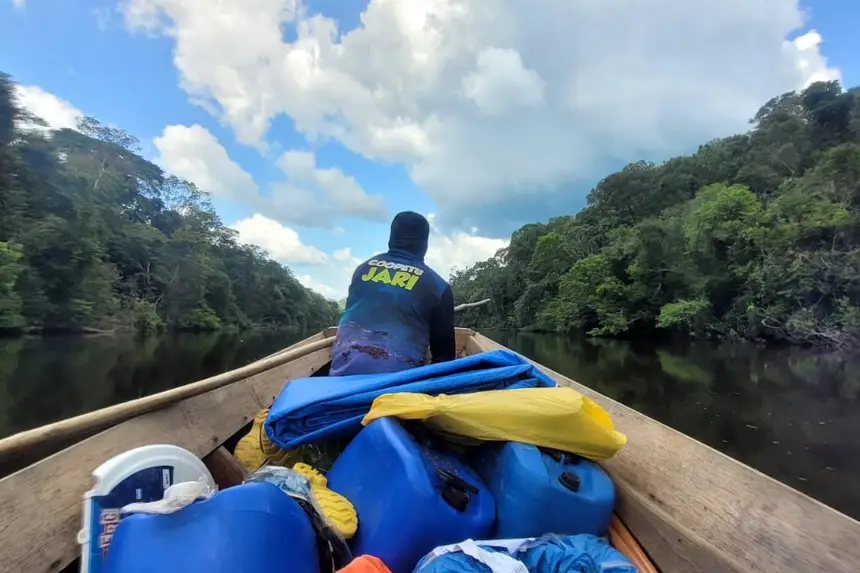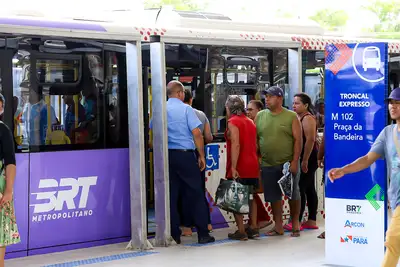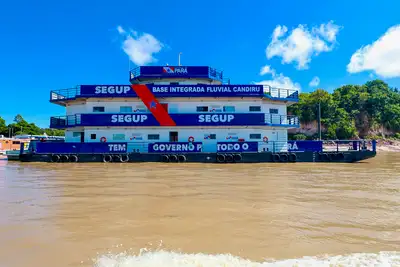Amazon Giant Trees State Park Advances to New Implementation Phase
The fieldwork opened the implementation cycle of the Park, created in 2024, and involved a complex operation, with routes totaling over 200 kilometers between river and land displacements.
For two weeks, multidisciplinary teams traversed extensive areas of forest, rivers, and communities to define the location for the operational base of the Amazon Giant Trees State Park, in Almeirim, in the western region of Pará. The technical mission represents the beginning of the execution cycle for the infrastructure and management guidelines of the conservation unit. Environmental, logistical, and socioeconomic data were also mapped to support the next phases of the "Giant Trees for a New Era – Phase II" Project.
The initiative is led by the Government of Pará, through the Forest Development and Biodiversity Institute (Ideflor-Bio), in partnership with the Sustainable Amazon Foundation (FAS), Vonát Consulting and Training, and the Jari Valley Ecotourism Cooperative (Coopetu Jari), with support from the Andes Amazon Fund (AAF). The fieldwork opened the implementation cycle of the Park, created in 2024, and involved a complex operation, with routes totaling over 200 kilometers between river and land displacements.
The technical team faced rapids, waterfalls, and difficult access sections to reach the interior of the conservation unit. The territory recognition allowed for the mapping of safe routes, risk points, and areas of great scenic beauty, reinforcing the region's potential for ecotourism, adventure tourism, and nature observation. The collection of this information will be essential to structure the operational base of the Park, which will include a reception area, accommodations, kitchen, office, pier, and sustainable systems for photovoltaic energy and water capture.
Studies - During the mission, environmental and climatic assessments were conducted, trails were mapped, and sensitive areas and potential tourist attractions were identified. Living trees and fallen trunks were cataloged for possible sustainable use in the construction of future facilities, reducing the environmental impact of the work. This care reinforces the project's commitment to environmentally responsible implementation aligned with the principles of conservation and rational use of natural resources.
The activities also included workshops and technical visits to the communities of São Francisco do Iratapuru, Cachoeira Santo Antônio, São José, and Padaria. In these locations, awareness-raising meetings and training for tourism operators and guides were held on topics such as minimum competencies for guides and risk management. Socioeconomic questionnaires were applied to community leaders, aiming to support the formation of the Management Council and the development of the Park Management Plan, which will follow a participatory and inclusive methodology.
Environmental Milestone - The president of Ideflor-Bio, Nilson Pinto, highlighted the significance of the new implementation phase of the Park as a milestone in the State's environmental policy. “This new phase represents much more than the construction of an operational base — it is the beginning of a journey to transform a unique natural heritage into a space for knowledge, responsible tourism, and the generation of opportunities for local communities. Ideflor-Bio reaffirms its role as a guardian of the forests and promoter of a management model that values the Amazon and the people who live in it,” he emphasized.
For the FAS Public Policy, Climate, and Conservation Program Project Coordinator, Juliane Menezes, the mission consolidates the transition between planning and execution. “The first phase of the project was dedicated to the discovery and creation of the Park. Now, we are starting a practical phase, focusing on infrastructure implementation and strengthening community leadership. This mission was essential for planning actions in an integrated manner, reconciling conservation, research, and local income generation,” she stated.
The manager of the Belém Administrative Region of Ideflor-Bio and president of the Brazilian Trails Network, Júlio Meyer, highlighted the tourism and scientific potential of the conservation unit. “A park is a category of unit that aims for visitation. We are studying safe ways and immersive experiences for people to get to know this sanctuary of giant trees, abundant biodiversity, and traditional culture. The operational base will be essential to protect the territory, support research, and boost nature tourism to international standards,” he assessed.
Continuity - With the conclusion of the mission, the project advances to new phases, including the hiring of specialized companies for infrastructure construction and trail management. Participatory workshops for the development of the Management Plan and the formation of the Management Council, which will define the conservation and public use guidelines of the Park, are also planned. Capacity-building and mentoring actions for local tourism operators will continue, ensuring the integration of communities in the management process.
Created in September 2024, the Amazon Giant Trees State Park protects about 560,000 hectares of forest and is home to some of the largest trees ever recorded in Brazil — among them, the red angelim (Dinizia excelsa Ducke), with a height of 88.5 meters and approximately 400 years old.
The "Giant Trees for a New Era – Phase II" Project aims to consolidate this heritage based on science, sustainability, and the appreciation of traditional populations. With the advancement of this new phase, Pará reaffirms its leadership in forest conservation and sustainable development policies in the Amazon.














